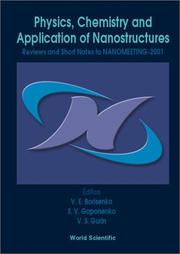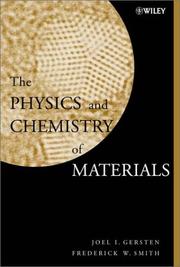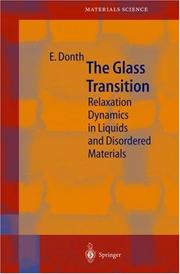| Listing 1 - 3 of 3 |
Sort by
|

ISBN: 1281951617 9786611951610 9812810072 9789812810076 9789810246181 9810246188 9781281951618 661195161X Year: 2001 Publisher: Singapore River Edge, NJ World Scientific
Abstract | Keywords | Export | Availability | Bookmark
 Loading...
Loading...Choose an application
- Reference Manager
- EndNote
- RefWorks (Direct export to RefWorks)
The book contains impressive results obtained in the XX-th century and discussion of next challenges of the XXI-st century in understanding of the nanoworld. The main sections of the book are: (1) Physics of Nanostructures, (2) Chemistry of Nanostructures, (3) Nanotechnology, (4) nanostructure Based Devices. Contents: Physics of Nanostructures: Polarons in Quantum Wells (A I Bibik et al.) Screening of Extra Point Charge in a Few Particle Coulomb System (N A Poklonski et al.) Electric Field Effect on Absorption Spectra of an
Nanostructures --- Solid state chemistry --- Nanotechnology --- Nanoscience --- Physics --- Industrial applications

ISBN: 0471057940 Year: 2001 Publisher: New York : Wiley,
Abstract | Keywords | Export | Availability | Bookmark
 Loading...
Loading...Choose an application
- Reference Manager
- EndNote
- RefWorks (Direct export to RefWorks)
materials science --- Physicochemistry --- Chemistry --- materiaalkennis --- Solid state chemistry. --- Solid state physics. --- Materials. --- Chimie de l'état solide --- Physique de l'état solide --- Matériaux --- 54-16 --- Solid state chemistry --- Materials --- Solid-state physics --- #WSCH:MODS --- Physics --- Solids --- Engineering --- Engineering materials --- Industrial materials --- Engineering design --- Manufacturing processes --- Chemistry, Solid state --- Chemistry, Physical and theoretical --- Solid phase --- Solid-state physics. --- 54-16 Solid phase --- Chimie de l'état solide --- Physique de l'état solide --- Matériaux

ISBN: 3540418016 3642075193 3662043653 Year: 2001 Volume: 48 Publisher: Berlin Springer
Abstract | Keywords | Export | Availability | Bookmark
 Loading...
Loading...Choose an application
- Reference Manager
- EndNote
- RefWorks (Direct export to RefWorks)
This is the first book dedicated to the glass transition since this concept became recognized as a distinct and independent field of investigation. The glass transition is a synonym for relaxation and dynamics in complex disordered systems, especially in liquids. It embraces time-scales ranging from picoseconds to years. The book describes and interrelates the following processes: cooperative alpha processes in a cold liquid, structural relaxation in the glass near Tg, the Johari-Goldstein beta process, the Williams-Götze process in a warm liquid, fast nonactivated cage rattling and boson peak, and ultraslow Fischer modes. By describing the salient facts, explaining and discussing the fundamentals, the author attempts to introduce a unifying concept for the entire material. The formulas, diagrams and references are carefully selected to illustrate the main current ideas about the glass transition.
Relaxation phenomena. --- Glass transition temperature. --- Amorphous substances. --- Phenomenes de relaxation --- Température de transition vitreuse --- Substances amorphes --- 544.23 --- Glassy solids (solid state chemistry) --- Température de transition vitreuse --- Amorphous substances --- Glass transition temperature --- Relaxation phenomena --- Phenomena, Relaxation --- Chemistry, Physical and theoretical --- Physics --- Viscoelasticity --- Glass transformation temperature --- Glass transitions --- Materials --- Phase transformations (Statistical physics) --- Transition temperature --- Thermal properties --- Crystallography. --- Thermodynamics. --- Physical chemistry. --- Materials science. --- Engineering. --- Crystallography and Scattering Methods. --- Physical Chemistry. --- Characterization and Evaluation of Materials. --- Engineering, general. --- Construction --- Industrial arts --- Technology --- Material science --- Physical sciences --- Chemistry, Theoretical --- Physical chemistry --- Theoretical chemistry --- Chemistry --- Dynamics --- Mechanics --- Heat --- Heat-engines --- Quantum theory --- Leptology --- Mineralogy
| Listing 1 - 3 of 3 |
Sort by
|

 Search
Search Feedback
Feedback About UniCat
About UniCat  Help
Help News
News